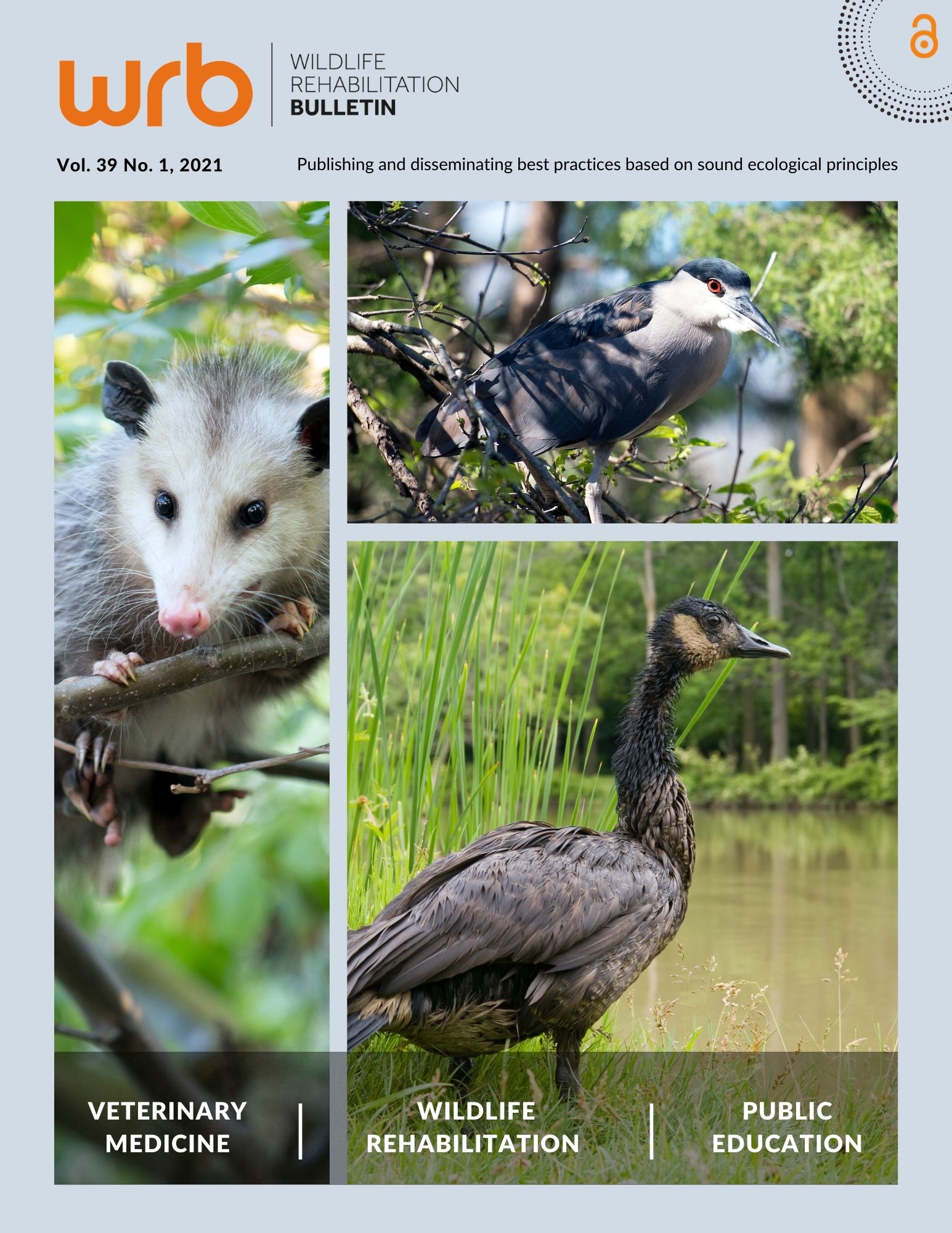Avian anaesthesia and analgesia
DOI:
https://doi.org/10.53607/wrb.v39.246Abstract
Wildlife rehabilitators are often presented with injured birds. We recognize that birds are not dogs and cats and, therefore, require specialized protocols for anaesthesia and analgesia. This paper discusses recent research on anaesthesia and analgesia in birds, with a focus on a multimodal approach to treatment. Rehabilitators will need to work closely with veterinarians to provide the best care for wild bird patients.
Downloads
References
Barron H.W. & Hawkins M. 2017. Classes on: avian analgesia: considerations for companion and wild birds and avian anesthesia—wild style. In course: ANES 100-0917 Wild adventures: anesthesia and analgesia in Wildlife. VIN Continual Education. October 11–November 18, 2017 Accessed on the internet at www.vin.com/ce/
Ceulemans S.M., Guzman D.S.M., Olsen G.H., Beaufrere H. & Paul-Murphy J.R. 2014. Evaluation of thermal antinociceptive effects after intra-muscular administration of buprenorphine hydrochloride to American Kestrels (Falco sparenus). American Journal of Veterinary Research 75, 705–710. doi: 10.2460/ajvr.75.8.705
Doss G.A., Fink D.M. & Mas C. 2018. Assessment of sedation after intranasal administration of midazolam and midazolam-butorphanol in cockatiels (Nymphicus hollandicus). American Journal of Veterinary Research 79(12), 1246–1252. doi: 10.2460/ajvr.79.12.1246
Edling T.M. 2006. Updates in anesthesia and monitoring. In G.J. Harrison & T.L. Lightfoot (eds.): Clinical avian medicine. Vol. 2. Pp. 748–60. Palm Beach: Spix Publishing.
Fowler M.E. 1995. Restrain and handling of wild and domestic animals. 2nd ed. Ames: Iowa State University Press. ISBN: 0-8138-1892-3.
Guzman D.S.M., Houck E.L., Knych H.K.D., Beaufrere H. & Paul-Murphy J.R. 2018. Evaluation of the thermal nociceptive effects and pharmacokinetics after intramuscular administration of buprenorphine hydrochloride to cockatiels (Nymphicus hollandicus). American Journal of Veterinary Research 79(12), 1239–45.
Hawkins M., Paul-Murphy J. & Guzman D.S.M. 2016. Recognition, assessment and management of pain in birds. In B.L. Speer (ed.): Current therapy in avian medicine and surgery. Pp. 616–30. St Louis, MI: Elsevier.
Hawkins M.G., Guzman D.S.M., Beaufrere H., Lennox A. & Carpenter, J.W. 2018. Birds. In J.W. Carpenter (ed.): Exotic animal formulary. 5th ed. Pp. 167–365. St Louis, MI: Elsevier.
Heard D. 2016. Anesthesia. In B.L. Speer (ed.): Current therapy in avian medicine and surgery. Pp. 601–15. St Louis, MI: Elsevier.
Lawtown M.P.C. & Howlett J.C. 2000. Anesthesia. In J. Samour (ed.): Avian medicine. Pp. 80–97. London: Mosby.
Lierz M. & Korbel R. 2012. Anesthesia and analgesia in birds. Journal of Exotic Pet Medicine 21, 44–58. doi: 10.1053/j.jepm.2011.11.008
Ludders J.W. 2015. Comparative anesthesia and analgesia of birds. In K.A. Grimm, L.A. Lamont, W.J. Tranquilli, S.A. Greene & S.A. Robertson (eds.): Veterinary anesthesia and analgesia: The fifth edition of Lumb and Jones. Pp. 800–16. Ames IA: John Wiley & Sons.
Malik A. & Valentine A. 2018. Pain in birds: A review for veterinary nurses. Veterinary Nursing Journal 33, 11–25. doi: 10.1080/17415349.2017.1395304
Montesinos A., Encinas T., Ardiaca M., Gilabert J.A., Bonvehi C. & Oros J. 2019. Pharmoacokinetics of meloxicam during multiple oral or intramuscular dose administration to African grey parrots (Psittacus erithacus). American Journal of Veterinary Research 80(2), 201–207. doi: 10.2460/ajvr.80.2.201
Paul-Murphy J. 2006. Pain management. In G.J. Harrison & T.L. Lightfoot (eds.): Clinical avian medicine. Vol. 1. Pp. 233–9. Palm Beach: Spix Publishing.
Paul-Murphy, J. & Fialkowski, J. 2001. Injectable anesthesia and analgesia of birds. In R.D. Gleed & J.W. Ludders (eds.): Recent advances in veterinary anesthesia and analgesia: companion animals. Ithaca, NY: IVIS. Accessed on the internet at https://www.ivis.org/library/recent-advances-veterinary-anesthesia-and-analgesia-companion-animals/injectable-0 on 18 May 2022
Raftery A. 2013. Avian anesthesia. In Practice 35, 272–278. doi: 10.1136/inp.f2861
Rupley A.E. 1997. Manual of avian practice. Philadelphia, PA: Saunders.
Scott D.E. 2021. Raptor medicine, surgery and rehabilitation. 3rd ed. Boston, MA: CABI.
Sinn L.C. 1994. Anesthesiology. In B.W. Ritchie, G.J. Harrison & L.R. Harrison (eds.): Avian medicine: Principles and application. Pp. 1066–80. Lake Worth, FL: Wingers Publishing.
Souza M.J., Guzman D.S.M., Paul-Murphy J.R. & Cox S.K. 2012. Pharmacokinetics after oral and intravenous administration of a single dose of tramadol hydrochloride to Hispaniolan Amazon parrots (Amazona ventralis). American Journal of Veterinary Research 73(8), 1142–1147. doi: 10.2460/ajvr.73.8.1142
Tseng F.S. 2007. Pain management in wildlife rehabilitation. In F.S. Tseng & M.A. Mitchell (eds.): Topics in wildlife medicine: emergency and clinical care. Vol 2. Pp. 98–111. St Cloud, MN: National Wildlife Rehabilitators Association.
Tully T.N., Jr. 2009. Birds. In M.A. Mitchell & T.N. Tully (eds.): Manual of exotic pet practice. Pp. 250–98. St Louis, MO: Saunders.
Yaw T.J., Zaffarano B.A., Gall A., Olds J.E., Wulf L., Papastavros E. & Coetzee J.F. 2015. Pharmacokinetic properties of a single administration of oral gabapentin in the Great Horned Owl (Bubo virginianus). Journal of Zoo and Wildlife Medicine 46(3), 547–552. doi: 10.1638/2015-0018.1
Zehnder A.M., Hawkins M.G. & Pascoe P.J. 2017. Avian anatomy and physiology. In G. West, D. Heard & N. Caulkett (eds.): Zoo animal and wildlife immobilization and anesthesia. Pp. 391–8. 2nd ed. Oxford: Wiley Blackwell.
Published
How to Cite
Issue
Section
Categories
License
Copyright (c) 2022 Kimberly A McMunn

This work is licensed under a Creative Commons Attribution-NonCommercial-NoDerivatives 4.0 International License.
The copyright for articles in this journal is retained by the author(s), with first publication rights granted to the Wildlife Rehabilitation Bulletin and NWRA. Articles published as open-access in this journal are free to use and share with proper attribution in educational and other non-commercial purposes. To obtain reprint permission for articles that are not open access, please contact the journal editor.







